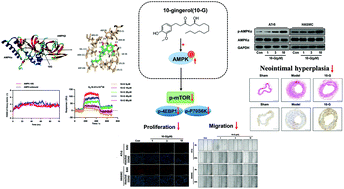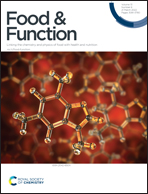10-Gingerol, a natural AMPK agonist, suppresses neointimal hyperplasia and inhibits vascular smooth muscle cell proliferation†
Abstract
Background: Abnormal proliferation of vascular smooth muscle cells (VSMCs) in the intimal region is a key event in the development of neointimal hyperplasia. 10-G, a bioactive compound found in ginger, exerted inhibitory effects on the proliferation of several cancer cells. However, the effect and mechanism of 10-G on neointimal hyperplasia are not clear. Purpose: To explore the suppressive effects of 10-G on the proliferation and migration of VSMCs, and investigate the underlying mechanisms. Methods: In vivo, a left common carotid artery ligation mouse model was used to observe the effects of neointimal formation through immunohistochemistry and hematoxylin–eosin staining. In vitro, the cell proliferation and migration of HASMCs and A7r5 cells were detected by MTS assay, EdU staining, wound healing assay, Transwell assay, and western blotting as well. Molecular docking, molecular dynamics simulations and surface plasmon resonance imaging were collectively used to evaluate the interaction of 10-G with AMP-activated protein kinase (AMPK). Compound C and si-AMPK were used to inhibit the expression of AMPK. Results: Treatment with 10-G significantly reduced neointimal hyperplasia in the left common carotid artery ligation mouse model. MST and EdU staining showed that 10-G inhibited the proliferation of VSMC cells A7r5 and HASMC. We also found that 10-G altered the expression of proliferation-related proteins, including CyclinD1, CyclinD2, CyclinD3, and CDK4. Molecular docking revealed that the binding energy between AMPK and 10-G is −7.4 kcal mol−1. Molecular simulations suggested that the binding between 10-G and AMPK is stable. Surface plasmon resonance imaging analysis also showed that 10-G has a strong binding affinity to AMPK (KD = 6.81 × 10−8 M). 10-G promoted AMPKα phosphorylation both in vivo and in vitro. Blocking AMPK by an siRNA or AMPK inhibitor pathway partly abolished the anti-proliferation effects of 10-G on VSMCs. Conclusion: These data showed that 10-G might inhibit neointimal hyperplasia and suppress VSMC proliferation by the activation of AMPK as a natural AMPK agonist.

- This article is part of the themed collection: Food & Function HOT Articles 2022


 Please wait while we load your content...
Please wait while we load your content...